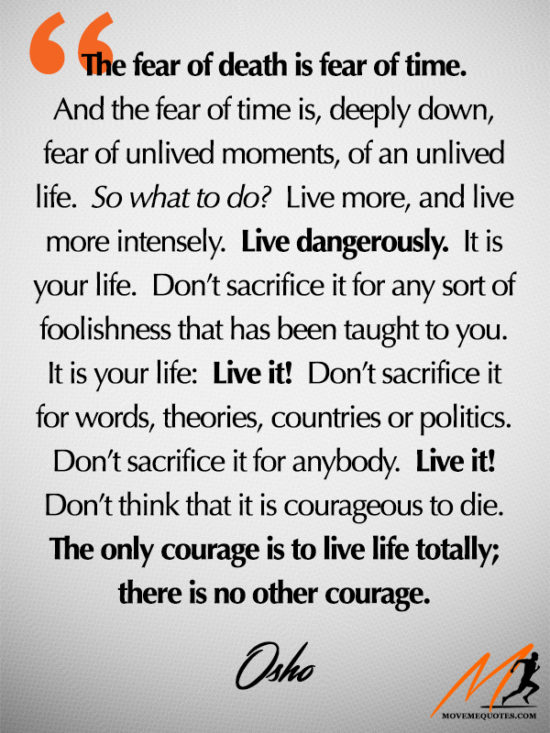Archives
The Art of Living and Dying [Book]
Book Overview: Why are we afraid of death? Should we tell someone they are dying? Is reincarnation true? With depth, clarity, compassion, and even humor, Osho answers the questions we all have about this most sacred of mysteries and offers practical guidance for meditation and support. He reveals not only that our fear of death is based on a misunderstanding, but that dying is an opportunity for inner growth. When life is lived consciously and totally, death is not a catastrophe but a joyous climax.
Post(s) Inspired by this Book:
“There is nothing to be worried about. You will disappear like a snowflake in pure air. You are not going to die, you are only going to disappear. Yes, you will not be found in the individual form. The form will disappear into the formless – the snowflake into the pure air. But you will be there and more so. When the river disappears into the ocean, it is not dying – it is becoming the ocean, it is spreading, it is becoming bigger, huge, enormous, infinite.” ~ Osho, The Art of Living and Dying
“Make the child aware of the mystery. Rather than giving the answer it is better to make the child aware of the mysterious that’s all around, so the child starts feeling more awe and more wonder. Rather than giving a pat answer it is better to create an inquiry. Help the child to be more curious, help the child to be more inquiring. Rather than giving the answer, make the child ask more questions. If the child’s heart becomes inquiring, that’s enough; that’s all parents can do for the child. Then the child will seek his or her own answers in his or her own way.” ~ Osho, The Art of Living and Dying
How To Upgrade the Quality of Your Mind (and Life)
Excerpt: Each sense acts as a floodgate that, when opened, unleashes information. This is the key to learning how to upgrade the quality of your mind.
Read More »How To Upgrade the Quality of Your Mind (and Life)
“If you have loved a person, when the person is gone you don’t feel relief – and you don’t cry and you don’t weep. In deep silence you accept the fact, the helplessness of it and the love continues – because love does not end with the body, love does not end with the mind. Love goes on flowing.” ~ Osho, The Art of Living and Dying
“Less and less memories will come as the time moves. There will be gaps – you would like to relive something but nothing is coming – and those gaps are beautiful. Then a day will come when you will not be able to move backwards because everything is complete. When you cannot move backwards, only then do you move forwards. Be finished with the past. As you become freer from the past, the mountain starts disappearing. And then you will attain unison: you will become, by and by, one.” ~ Osho, The Art of Living and Dying
“When sadness comes, be really sad. Don’t try to escape from it – allow it, cooperate with it. Let it dissolve in you and you be dissolved in it. Become one with it. Be really sad: no resistance, no conflict and no struggle. When happiness comes, be happy: dance and be ecstatic. When happiness comes, don’t try to cling to it. Don’t say that it should remain always and always; that is the way to miss it. When sadness comes, don’t say, ‘Don’t come to me,’ or, ‘If you have come, please go soon.’ That is the way to miss it. Don’t reject sadness and don’t cling to happiness.” ~ Osho, The Art of Living and Dying
“Sadness has a song… a very deep phenomenon is sadness. Accept it. Enjoy it. Taste it without any rejection, and you will see that it brings many gifts to you which no happiness can ever bring. If you can accept sadness it is no longer sadness; you have brought a new quality to it. You will grow through it. Now it will not be a stone, a rock on the path blocking the way; it will become a step.” ~ Osho, The Art of Living and Dying
“Sadness is sad because you dislike it. The sadness is sad because you would not like to be in it. The sadness is sad because you reject it. Even sadness becomes a flowering of tremendous beauty, of silence and of depth, if you like it. Happiness is always shallow; sadness, always deep. Happiness is like a wave; sadness is like the innermost depth of an ocean. In sadness you remain with yourself, left alone. In happiness you start moving with people and you start sharing. In sadness you close your eyes and you delve deep within yourself.” ~ Osho, The Art of Living and Dying
“Old age is tremendously beautiful, and it should be so because the whole of life moves towards it. It should be the peak. How can the peak be in the beginning? How can the peak be in the middle? But if you think your childhood is your peak, as many people think, then of course your whole life will be a suffering because you have attained your peak – now everything will be a declining, coming down. If you think young age is the peak, as many people think, then of course after thirty-five you will become sad, depressed, because every day you will be losing and losing and losing and gaining nothing. The energy will be lost, you will weaken, diseases will enter into your being, and death will start knocking at the door. The home will disappear, and the hospital will appear. How can you be happy? No, but in the East we have never thought that childhood or youth is the peak. The peak waits for the very end.” ~ Osho, The Art of Living and Dying
“If you have lived your life, you will welcome death. It will come like a rest, like a great sleep. If you have peaked, climaxed in your life, then death is a beautiful rest, a benediction. But if you have not lived, then of course death creates fear. If you have not lived, then certainly death is going to take time from your hands, all future opportunities to live. In the past you have not lived, and there is going to be no future: fear arises. Fear arises not because of death but because of unlived life.” ~ Osho, The Art of Living and Dying
“Once you know what death is you will receive it with great celebration. You will welcome it. It is the fulfillment of your whole life’s effort. It is the fruition of your whole life’s effort. The journey ends. One comes back home. In death you don’t die. Just, the energy that was given to you through the body and through the mind is released and goes back to the world. You return home.” ~ Osho, The Art of Living and Dying
The fear of death is the fear of time.
Picture Quote Text:
“The fear of death is fear of time. And the fear of time is, deeply down, fear of unlived moments, of an unlived life. So what to do? Live more, and live more intensely. Live dangerously. It is your life. Don’t sacrifice it for any sort of foolishness that has been taught to you. It is your life: Live it! Don’t sacrifice it for words, theories, countries or politics. Don’t sacrifice it for anybody. Live it! Don’t think that it is courageous to die. The only courage is to live life totally; there is no other courage.” ~ Osho, The Art of Living and Dying
“The fear is not of death, the fear is of time, and if you look deeply into it then you find that the fear is of an unlived life – you have not been able to live. If you live, then there is no fear. If life comes to a fulfillment there is no fear. If you have enjoyed, attained the peaks that life can give – if your life has been an orgasmic experience, a deep poetry vibrating within you, a song, a festival, a ceremony, and you lived each moment of it to its totality – then there is no fear of time. Then the fear disappears.” ~ Osho, The Art of Living and Dying
“Just think of someone who has never come across a mirror. Can he close his eyes and see his face? Impossible. He cannot even imagine his face, he cannot meditate on it. But a man who has come to a mirror, looked into it, known his face through it, can close his eyes and see the face inside. That’s what happens in relationship. When a person moves into a relationship the relationship mirrors, reflects himself, and he comes to know many things that he never knew existed in him.” ~ Osho, The Art of Living and Dying







